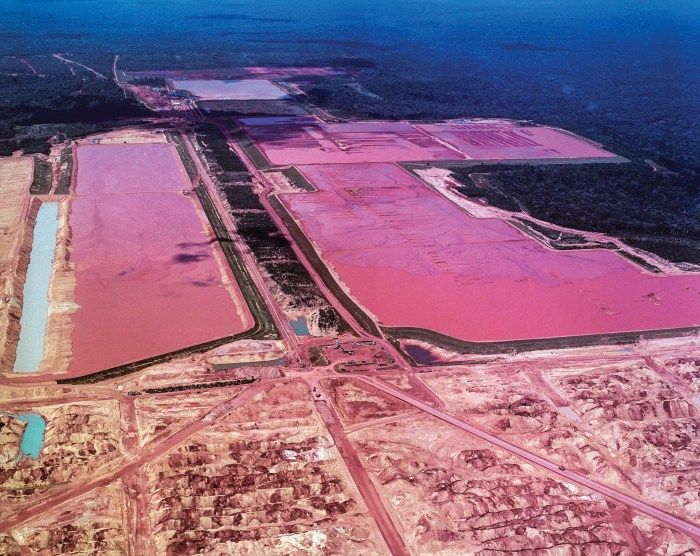Creating Value Out of Aluminium Waste in India
Published on by Water Network Research, Official research team of The Water Network in Academic
Disposal of aluminium industry waste, chiefly the bauxite residue called red mud is a worldwide concern, but especially in developing countries like India.

Aerial view of bauxite processing facility showing red mud ponds
The high alkalinity of red mud and the presence of toxic materials in it pose a serious ecological hazard.
Which is why the aluminium industry has been brainstorming to overcome the problem associated with red mud disposal. The remedies have ranged from dumping the waste into open, artificial settling pools to treating them in red mud processing units. Some shore based alumina refineries have also opted for discarding the waste into the sea given the sea water’s ability to neutralise the high alkalinity in red mud. What’s more, the iron content in the waste residue when unleashed into the sea supports marine life.
Decoding India’s aluminium waste & efforts for reuse
The major solid wastes produced during the alumina-aluminium value chain include dross, red mud and spent pot lining (SPL). India produces some 0.12 million tonne of dross, five million tonne of red mud and 35,000 SPL each year. Though considerable R&D work has been done across many countries for effective utilisation of such wastes, commercialisation of these wastes has not gained a foothold in India. In order to meet environmental sustainability, it is imperative to convert these wastes into valuable products as such conversions will also ensure sustainability for aluminium industries.
The creation of dross in the casting process is a generic problem. Until India switches over to technology that eliminates dross entirely, dross treatment and management needs attention. In India, a few government organizations working together with aluminium industry players have taken up some R&D projects pertaining to red mud, SPL and dross to establish viable solutions to dispose of these waste materials.
Examples range from creating ceramic glass tiles from red mud to the destruction of cyanide in SPL material or low ferric alum from dross. The utilization of red mud, fly ash and SPL can conserve the quality of natural resources such as clay and sand required for making bricks, titles etc.
Thereby, this process yields dual benefits: on one hand, it puts waste vis red mud, fly ash, SPL and dross to good use, and on the other it enhances the sustainability of the aluminium industry. Not only are these solutions environmentally friendly, some are also commercially viable if proprely implemented.
Analysing waste and regulation of its disposal
It is important to analyze the waste mud from alumina/aluminium industries for their elemental constitutions and determine the presence or absence of hazardous elements such as arsenic, cadmium, lead et al. Most of the muds can be used for land reclamation, for the construction of site dams or embankments or as a feed material for other extraction processes because of the high iron content.
But, aluminium waste, particularly SPL can be hazardous if not managed properly. India still lacks a specific regulation on SPL disposal though the pollution control authorities at the central and state levels are keeping tabs on solid waste disposal from the aluminium industries. With expanding production of both alumina and aluminium, the players can fall back on bioremediation technology to address the problem of red mud being dumped into ponds.
India’s growing aluinium production means that waste disposal should form the cornerstone of all future projects. Aluminium production in India has expanded from 2.15 million tonnes in FY15 to 3.23 million tonnes in FY16 and by the end of FY17, it is projected at 4.12 million tonnes.
Aluminium consumption in the country, too, is in a positive territory, poised to grow from 3.3 million tonnes now to 5.3 million tonnes in 2020, according to a report by global ratings, research and policy advisory Crisil. Currently, the country produces 10 million tones of alumina each year and this could escalate in the future as the primary producers look to expand aluminium production.
Developing red mud applications for the future
Many projects on the use of red mud for several applications have been funded by the primary metal producers in India. This includes development processes for the manufacture of artificial ceramic stone chip, constructional bricks as building material and stabilized blocks for protection of land erosion by sea water and bench scale studies for development of glass ceramics and development of lightweight aggregate.
A future application could be the recovery of valuable metals- a technically feasible but economically unsound process. A balanced collaboration between the aluminium industry, niche R&D institutes and entrepreneurs could however deliver results.
Looking ahead, the reuse of red mud and developing its prospective applications in the Indian context need to be guided by factors like volume, performance, cost and risk. The chosen application should have a high volume usage, be cost effective and bereft of any environmental risk. Also, the selected red mud application needs to be a low cost substitute for some other material in demand while promising either the same or a higher level of performance.
Red mud applications currently seem challenging in the Indian scenario. Though tie-ups between the industry and academic institutions have come out with useful products, pilot studies on their applicability are yet to be carried out. So far, no marketing studies have been conducted to determine where such products could be absorbed.
Lastly comes from absence of government subsidies to attract entrepreneurs for setting up units engaged in developing products out of red mud.
Read more at: Aluminium Insider
Media
Taxonomy
- Soil Conservation
- Waste Disposal
- Waste Disposal
- Regulations
- Pollution
- Waste Management
- Environmental
- Water & Wastewater
- India